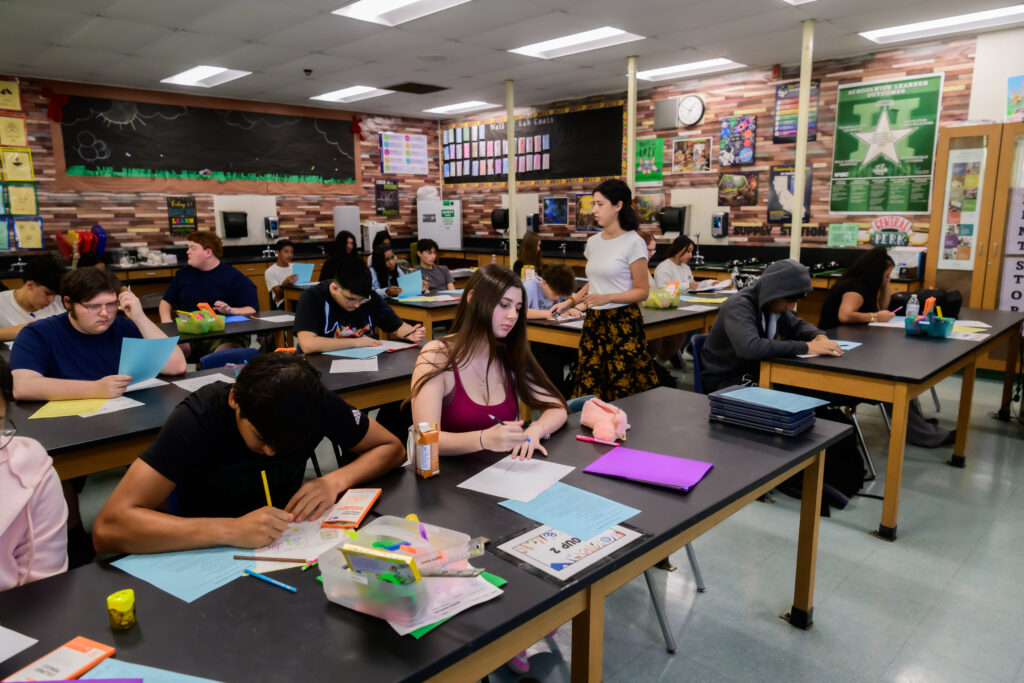TOP TAKEAWAYS
- The Covid-19 pandemic amplified long-standing inequalities; there are no quick fixes to high chronic absentee rates and other challenges.
- A return to “normal” won’t address post-Covid students feeling disengaged – nor should it.
- Unlike other states, California districts have a $6 billion Covid block grant to replace federal relief that expired.
In March 2020, the Covid pandemic shut down schools, creating havoc, particularly among California’s most vulnerable children. Five years later, despite unprecedented funding from the state and federal governments, most districts continue to struggle to recover the ground they lost amid multiple challenges: more disgruntled parents and emotionally fragile students, a decline in enrollment, and uncertain finances.
According to calculations by researchers at Stanford and Harvard universities, most California school districts remain below pre-pandemic levels in standardized test scores — 31% of a grade equivalent below in math and 40% of a grade equivalent in reading. These averages understate the widening gaps in living conditions as well as test scores between the lowest-income and least-impoverished districts and schools.
The drop in the average scores in California and the nation on the National Assessment of Educational Progress in 2024 “masks a pernicious inequality,” said Sean Reardon, faculty director of the Educational Opportunity Project at Stanford.
Scores are a shorthand measurement of learning, and they do not address the deeper, latent impact of the pandemic.
“We tend to overlook the longer-term effects of the delay in socialization and self-discipline — things that schools nurtured in young people,” said Vito Chiala, principal of William C. Overfelt High, whose 1,400 primarily low-income Hispanic and Vietnamese American students live in East San Jose. “Young people becoming adults at the high school level seem to be maybe two or three years behind where it used to be.”
In the first year of returning from remote learning, the focus was on school-related behaviors and self-management, Chiala said. “Students who had spent over a year saying whatever they wanted on social media had to face people in person, and that was super-uncomfortable sometimes. Now it’s much more about endurance, being willing and able to do hard academic work for longer periods of time.”
Overfelt High is far from unique. The National Center for Education Statistics reported that in 2021-22, 87% of public schools said the pandemic harmed student socioemotional development, and 56% reported increased incidents of classroom disruptions from student misconduct.
Educators, in turn, have taken a more holistic approach to building students’ mindsets and meeting families’ basic needs, said Bruce Fuller, a professor of education and public policy at the University of California Berkeley, who is studying nine California districts’ post-Covid responses.
Recognizing that Covid amplified the harsh conditions of living in poverty, Gov. Gavin Newsom and legislators put $4 billion into creating community schools in low-income neighborhoods to strengthen ties to parents and open health clinics at schools. The state began to fund free universal school breakfasts and lunches.
With state grants, Rocketship Public Schools hired care coordinators in all of its charter schools, most in East San Jose, to cope with the aftermath of Covid.
Fabiola Zamora, a mother of four children from ages 2 to 10, described the support from the care corps coordinator for her school when she became homeless. “We received blankets, diapers, warm clothes. Mrs. Martinez guided me to a shelter and helped get my daughter to school,” she said. “It was hard. I was scared; it made me feel I wasn’t alone.”
Mental health responses
The proportion of students experiencing mental health issues had been rising before Covid. It accelerated during remote learning and coincided with an explosion of social media and cell phone use. The Journal of the American Medical Association reported that the incidence and prevalence of depression among 1.7 million 5- to 22-year-olds served by Kaiser Permanente in Southern California rose by about 60%, and the incidence of anxiety increased 31% from 2017 to 2021.
School districts in turn hired more counselors and psychologists using mental health funding and $13.4 billion the state received from the federal American Rescue Plan Act of 2021, the last and biggest installment of the $23.4 billion in Covid aid from Congress. Savvy districts have tapped Medi-Cal, the California version of Medicaid, to reimburse school mental health services, although Republican plans for massive cuts to Medicaid could jeopardize the funding.
Addressing the whole child makes sense. Disengaged and depressed students can’t focus; chronically absent students fall behind, complicating efforts to catch them up while moving others ahead.
But have these added responsibilities overburdened and preoccupied districts? In a fifth-year Covid reassessment, Robin Lake, director of the Center for Reinventing Public Education at Arizona State University, and Paul Hill, the center’s founder, raised that issue. “By easing up on graduation requirements” (which the California Legislature did), “making it easier for students to earn good grades, excusing frequent absences, and prioritizing social-emotional learning curricula over core academics,” they wrote, “the pendulum has swung too far away from the core business of schooling.”
Stubbornly high chronic absenteeism
The persistently high rates of chronic absences in California since Covid underscore complex challenges. In the first full year back from remote learning, chronic absenteeism nearly tripled statewide from 12% in 2018-19 to 30%, mirroring that of other states.
Just as with test scores, the averages masked yawning differences between ethnic and racial groups and levels of poverty: 35% for Hispanics, 42.5% for Black students, and 46% for homeless and foster youths, compared with 11% for Asian and 23% for white students. Students are chronically absent when they miss 10% or more days of school.
By 2023-24, the statewide rate declined, first to 25% in 2022-23 and then to 20% — still two-thirds higher than pre-Covid. An analysis by researchers Heather Hough of Policy Analysis for California Education and Hedy Chang of Attendance Works helps explain why learning recovery has been slow in impoverished schools. Only 2% of schools with the fewest low-income students had high or extreme levels of chronic absences, compared with 72% of schools in which three-quarters or more of students were low-income. The disparity isn’t new; the dimensions of the divide are.
“If you want to reduce chronic absence, you need to solve the root causes that result in kids not showing up to school in the first place,” said Attendance Works founder Chang. “The barriers — poor transportation, homelessness and food insecurity — are huge, and these issues are hard to solve.”
Schools also had a messaging problem. “During the pandemic, we said, ‘You should stay home for any reason for illness, any symptom.’ I don’t think we had counter-messaging when we wanted kids to come back.”
“The imperception was maybe missing school doesn’t matter so much if I think my kid might be sick,” Chang said.
Some high school students reached the same conclusion, added Overfelt principal Chiala. “We always said school is mandatory, school is important. And then we said for a year and a half (during remote learning) it wasn’t,” he said. “I think psychologically, a lot of young people are like, ‘”If it was really important, you would’ve made me keep coming.’”
Computers for all students
There is an unmistakable positive legacy of Covid: the equitable spread of technology after initial chaos.
Covid caught the state flat-footed, without a plan or the capacity to switch on a dime to remote learning; in many districts, this did not go well, as kids with home computers but spotty internet drove to fast-food parking lots to download the week’s homework assignments and to upload their answers.
In June 2020, the California Department of Education estimated that 700,000 students lacked a home computer — which soon rose to 1 million, or about 17% of students — and that there were 322,000 hot spots for internet service.
State Superintendent of Public Instruction Tony Thurmond created the Bridge the Divide Fund. With $18.4 million in donations, it distributed 45,000 Chromebooks, plus 100,725 hot spots.
The difference-maker arrived in 2021 with $7 billion as California’s share of the Biden administration’s Emergency Connectivity Fund. Federal funds have enabled more than 75% of schools nationwide to provide a computer for every student, and more than 80% of schools have high-speed broadband service, said Evan Marwell, the founder of the San Francisco-based nonprofit EducationSuperhighway.
Soon, it will be time to recycle personal computers. The good news, Marwell said, is a Chromebook can now be bought for $200.
Low return on federal investment?
On the 2021-22 Smarter Balanced tests, low-income students fell back after years of slow improvement. The overall 35% proficiency in English language arts was 4 percentage points lower than in pre-pandemic 2018-19. The 21% proficiency in math was a drop of 6 percentage points. Two years later, low-income students had regained half of what they had lost on both tests.
During these three years, per-student spending in California mushroomed by about 50% per student because of federal Covid relief and one-time state funding due to record-setting revenues, according to data assembled by Edunomics Lab, an education finance organization. The combination of high spending and lower test scores earned California one of the nation’s worst “returns on investments.”
However, a newly released deeper analysis of district-by-district Smarter Balanced results by researchers at UC San Diego, American Institutes of Research, UC Berkeley and Public Policy Institute of California showed that two years of federal Covid spending had a statistically significant effect in 2021-22. It was equivalent to a gain in math and English language arts of about 10 days of learning, said economics professor Julian Betts of UC San Diego.
Schools that reopened a year earlier from remote learning than most schools in California showed a bigger gain: about 20 days of learning.
However, those positive factors were not big enough to offset the effects of poverty — a loss of a quarter year of learning for schools with a high percentage of low-income students.
Researchers also looked at the results of the California Healthy Kids Survey that students fill out annually to see if there was a correlation between widespread bullying and student harassment with test scores. The effect was large: the equivalent of a half-year of lost learning in math and a third of a year in English language arts in 2021-22. The data document what socio-emotional learning advocates have preached for years: School climate matters in recovering academically from Covid declines.

One last source of funding
Starting with the 2021-22 state budget, Gov. Gavin Newsom and the Legislature invested more than $10 billion in TK-12 in the post-Covid years. The bulk of it went to transitional kindergarten (TK) and extended learning programs. What Newsom didn’t direct funding to were comprehensive, statewide, early reading and numeracy programs and high-intensive tutoring — two strategies that other states like Louisiana funded to respond Covid-era declines in test scores. Newsom had proposed $2.6 billion for “high-dosage” in-school tutoring; it vanished in the final budget.
What did survive was a $6 billion Learning Loss Emergency Block Grant program. Apparently unique among states in providing substantial money beyond the expiration of the $23.4 billion federal Covid funding, it directs most money to heavily low-income districts through 2026-27. In settling the Cayla J. lawsuit filed by Oakland and Los Angeles families over the state’s failure to meet their children’s education needs during remote learning, the state agreed to require that districts use the block grant for evidence-based strategies, like high-dosage tutoring. Districts must also conduct a needs assessment study, create a plan for the money, and present it to the public.
The learning recovery block grant provides an opportunity to ask questions raised by the Center for Reinventing Public Education in its five-year reassessment:
- What worked and didn’t work over the last five years?
- How are the students most in need going to get extra time and attention?
- What skills and new work habits are required of teachers?
Authors Robin Lake and Paul Hill concluded that the needed systemic changes would be “a heavy lift.” The necessary changes “probably can’t be done unless state officials seriously consider major waivers of regulation and teacher unions allow experimentation with new teacher roles and school staffing rules.”

Bruce Fuller, the UC Berkeley professor who is analyzing the learning recovery plans of 700 California districts, agrees. “It’s hard to sustain anything that’s seriously innovative,” he said.
Vito Chiala at Overfelt High in San Jose, however, said Overfelt is becoming a different place. “When we came back (from remote learning), we really spent a lot of time radically dreaming about how will we treat our kids? How will we grade work? How, what will we be teaching them? How will we embrace our students’ humanity?”
The result: “We don’t grade the same way we used to. Classes aren’t rushing through curriculum like they used to. Teachers aren’t feeling they have to move on, even though half the class hasn’t learned. We’re really trying to motivate students to feel the intrinsic need to learn and get better.”
“We’re still finding our footing in sort of this post-pandemic world,” he said.



